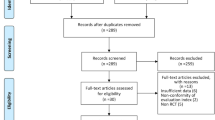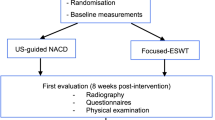Abstract
Objective
To determine the cost-effectiveness of rotator cuff hydroxyapatite deposition disease (HADD) treatments.
Method
A 1-year time horizon decision analytic model was created from the US healthcare system perspective for a 52-year-old female with shoulder HADD failing conservative management. The model evaluated the incremental cost-effectiveness ratio (ICER) and net monetary benefit (NMB) of standard strategies, including conservative management, ultrasound-guided barbotage (UGB), high- and low-energy extracorporeal shock wave therapy (ECSW), and surgery. The primary effectiveness outcome was quality-adjusted life years (QALY). Costs were estimated in 2022 US dollars. The willingness-to-pay (WTP) threshold was $100,000.
Results
For the base case, UGB was the preferred strategy (0.9725 QALY, total cost, $2199.35, NMB, $95,048.45, and ICER, $33,992.99), with conservative management (0.9670 QALY, NMB $94,688.83) a reasonable alternative. High-energy ECSW (0.9837 QALY, NMB $94,805.72), though most effective, had an ICER of $121, 558.90, surpassing the WTP threshold. Surgery (0.9532 QALY, NMB $92,092.46) and low-energy ECSW (0.9287 QALY, NMB $87,881.20) were each dominated. Sensitivity analysis demonstrated that high-energy ECSW would become the favored strategy when its cost was < $2905.66, and conservative management was favored when the cost was < $990.34. Probabilistic sensitivity analysis supported the base case results, with UGB preferred in 43% of simulations, high-energy ECSW in 36%, conservative management in 20%, and low-energy ECSW and surgery in < 1%.
Conclusion
UGB appears to be the most cost-effective strategy for patients with HADD, while surgery and low-energy ECSW are the least cost-effective. Conservative management may be considered a reasonable alternative treatment strategy in the appropriate clinical setting.




Similar content being viewed by others
References
Uhthoff HK, Loehr JW. Calcific Tendinopathy of the rotator cuff: pathogenesis, diagnosis, and management. J Am Acad Orthop Surg. 1997;5(4):183–91.
Suzuki K, Potts A, Anakwenze O, Singh A. Calcific tendinitis of the rotator cuff: management options. J Am Acad Orthop Surg. 2014;22(11):707–17.
Uhthoff HK, Sarkar K, Maynard JA. Calcifying tendinitis: a new concept of its pathogenesis. Clin Orthop Relat Res. 1976;118:164–8.
Speed CA, Hazleman BL. Calcific tendinitis of the shoulder. N Engl J Med. 1999;340(20):1582–4.
Sanders GD, Neumann PJ, Basu A, Brock DW, Feeny D, Krahn M, et al. Recommendations for Conduct, Methodological practices, and reporting of cost-effectiveness analyses: second panel on cost-effectiveness in health and medicine. JAMA. 2016;316(10):1093–103.
Bm B. Calcium deposits in the shoulder and subacromial bursitis: a survey of 12,122 shoulders. JAMA. 1941;116(22):2477–82.
Arirachakaran A, Boonard M, Yamaphai S, Prommahachai A, Kesprayura S, Kongtharvonskul J. Extracorporeal shock wave therapy, ultrasound-guided percutaneous lavage, corticosteroid injection and combined treatment for the treatment of rotator cuff calcific tendinopathy: a network meta-analysis of RCTs. Eur J Orthop Surg Traumatol. 2017;27(3):381–90.
Louwerens JKG, Sierevelt IN, Kramer ET, Boonstra R, van den Bekerom MPJ, van Royen BJ, et al. Comparing ultrasound-guided needling combined with a subacromial corticosteroid injection versus high-energy extracorporeal shockwave therapy for calcific tendinitis of the rotator cuff: a randomized controlled trial. Arthroscopy. 2020;36(7):1823-1833e1821.
Ogon P, Suedkamp NP, Jaeger M, Izadpanah K, Koestler W, Maier D. Prognostic factors in nonoperative therapy for chronic symptomatic calcific tendinitis of the shoulder. Arthritis Rheum. 2009;60(10):2978–84.
del Cura JL, Torre I, Zabala R, Legorburu A. Sonographically guided percutaneous needle lavage in calcific tendinitis of the shoulder: short- and long-term results. AJR Am J Roentgenol. 2007;189(3):W128-134.
Yoo JC, Koh KH, Park WH, Park JC, Kim SM, Yoon YC. The outcome of ultrasound-guided needle decompression and steroid injection in calcific tendinitis. J Shoulder Elbow Surg. 2010;19(4):596–600.
Farin PU, Rasanen H, Jaroma H, Harju A. Rotator cuff calcifications: treatment with ultrasound-guided percutaneous needle aspiration and lavage. Skeletal Radiol. 1996;25(6):551–4.
Lin JT, Adler RS, Bracilovic A, Cooper G, Sofka C, Lutz GE. Clinical outcomes of ultrasound-guided aspiration and lavage in calcific tendinosis of the shoulder. HSS J. 2007;3(1):99–105.
Gerdesmeyer L, Wagenpfeil S, Haake M, Maier M, Loew M, Wortler K, et al. Extracorporeal shock wave therapy for the treatment of chronic calcifying tendonitis of the rotator cuff: a randomized controlled trial. JAMA. 2003;290(19):2573–80.
Peters J, Luboldt W, Schwarz W, Jacobi V, Herzog C, Vogl TJ. Extracorporeal shock wave therapy in calcific tendinitis of the shoulder. Skeletal Radiol. 2004;33(12):712–8.
Hsu CJ, Wang DY, Tseng KF, Fong YC, Hsu HC, Jim YF. Extracorporeal shock wave therapy for calcifying tendinitis of the shoulder. J Shoulder Elbow Surg. 2008;17(1):55–9.
Rebuzzi E, Coletti N, Schiavetti S, Giusto F. Arthroscopy surgery versus shock wave therapy for chronic calcifying tendinitis of the shoulder. J Orthop Traumatol. 2008;9(4):179–85.
Seil R, Litzenburger H, Kohn D, Rupp S. Arthroscopic treatment of chronically painful calcifying tendinitis of the supraspinatus tendon. Arthroscopy. 2006;22(5):521–7.
Muennig PBM. Cost-Effectiveness Analysis in Health. 3rd ed. San Francisco, CA: Wiley; 2016.
Oudelaar BW, Huis In ‘t Veld R, Ooms EM, Schepers-Bok R, Nelissen R, Vochteloo AJH. Efficacy of adjuvant application of platelet-rich plasma after needle aspiration of calcific deposits for the treatment of rotator cuff calcific tendinitis: a double-blinded, randomized controlled trial with 2-year follow-up. Am J Sports Med. 2021;49(4):873–82.
Klarenbach S, Cameron C, Singh S, Ur E. Cost-effectiveness of second-line antihyperglycemic therapy in patients with type 2 diabetes mellitus inadequately controlled on metformin. CMAJ. 2011;183(16):E1213-1220.
Author information
Authors and Affiliations
Corresponding author
Ethics declarations
Conflict of interest
Erin F. Alaia is a paid Consultant of Biorez, Inc. (unrelated). Michael J. Alaia is a paid Consultant of JRF, Bodycad, and Mitek and received research support from Orcosa and Arthrex (unrelated). Naveen Subhas, Madalena Da Silva Cardoso, Zachary I. Li, Mehul R. Shah, and Soterios Gyftopoulos declare no competing interests.
Additional information
Publisher's note
Springer Nature remains neutral with regard to jurisdictional claims in published maps and institutional affiliations.
Supplementary Information
Below is the link to the electronic supplementary material.
Rights and permissions
Springer Nature or its licensor (e.g. a society or other partner) holds exclusive rights to this article under a publishing agreement with the author(s) or other rightsholder(s); author self-archiving of the accepted manuscript version of this article is solely governed by the terms of such publishing agreement and applicable law.
About this article
Cite this article
Alaia, E.F., Subhas, N., Da Silva Cardoso, M. et al. Common treatment strategies for calcium hydroxyapatite deposition disease: a cost-effectiveness analysis. Skeletal Radiol 53, 437–444 (2024). https://doi.org/10.1007/s00256-023-04424-2
Received:
Revised:
Accepted:
Published:
Issue Date:
DOI: https://doi.org/10.1007/s00256-023-04424-2




